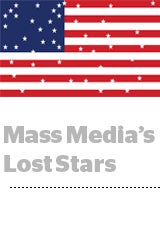 The extreme fragmentation of digital media is tougher on national political campaigns than on brand advertisers.
The extreme fragmentation of digital media is tougher on national political campaigns than on brand advertisers.
Because political campaigns must fight for every vote (at least once the primaries are done), discrete audiences that a brand marketer might dismiss as too difficult or small are essential to the political advertiser. The 3% of American adults that still connect via dial-up modem could make the difference between victory or defeat.
The performance marketing company Fluent, which runs email fundraising campaigns for super PACs and advocacy groups from both parties, said its client data showed that 4% of email accounts on their lists were from AOL. While Google’s Gmail comprised half of all addresses and had 13x higher open rates, AOL accounts had the most fundraising dollars for January.
“AOL is associated with an older audience,” said Collective VP of political sales Peter Pasi. He noted Hillary Clinton’s takeover of the AOL login page on the day of the Democratic debate last week.
By contrast, because Senator Bernie Sanders relies on a younger demographic, Pasi expected his team to pursue a mobile-first campaign.
Andrew Drechsler, president of HaystaqDNA, Sanders’ data and analytics vendor, pointed to a string of apps the campaign has spearheaded: one dubbed “Field the Bern” that centralizes data on potential voters gathered by volunteers, another that allows text message-to-app donations and an Apple TV app.
“The idea of mass audience has changed a lot,” said Amy Mitchell, director of journalism research for the Pew Research Center. “There is a real difference in the portion of the population that’s learning about what’s happening on local or network news, cable TV, social media or at niche outlets.”
Mitchell pointed to mobile trends in particular, noting that a growing number of people are reliant on smartphones for Internet access. This group includes 15% of the population aged 18-29, 12% of African Americans and 13% of Latinos. For these millions of prospective voters, desktop generates zero impressions.
There’s another, more practical factor impacting the efficacy of mobile outreach: Roughly half of all smartphone-dependent respondents to Pew’s survey said they experience termination of service or activity due to data and financial constraints. This stratification of audience accessibility is forcing politicians to rethink their marketing mix.
TV-Video Crossover
Television, despite its long history and proven effectiveness as an advertising forum, has become so fragmented that its definition now includes digital video.
“There’s a dash to become screen agnostic,” said Jordan Lieberman, president of the voter-targeting platform Campaign Grid. “I don’t care if my video spot hits you through DirecTV or through a premium inventory pre-roll ad; I just care that you saw the ad.”
But some channels like over-the-top devices (OTT) haven’t matured enough to address political needs, despite rapid user adoption. This effectively creates holes in target voter segments that are difficult to fill.
For instance, the conservative data firm i360 would like to place more client budgets in streaming TV, but according to company president Michael Palmer the cable companies and streaming providers haven’t developed the individual targeting capabilities political campaigns want.
Drechsler also said that D2, an addressable TV ad service that uses data pooled by DirecTV and Dish Network, is a good example of what politicians need, but isn’t currently being done at the pace politics demands. Last October the turnaround on voter-file matching was up to four weeks, and now it’s less than two – which he said is still generally too slow to respond at the pace of an election news cycles.
In other cases, TV activity has been consumed by social. More than twice as many 18-24 year olds watched the Snapchat story version of the first Republican debate than on television, according to Politico, evens though the debate drew record viewer numbers. But off-the-record digital consultants claim “the cycle is moving too fast for (Snapchat) to capture a sizable share of campaigns budgets,” according to the campaign consulting trade journal Campaigns & Elections.
The Winners
As usual, Google and Facebook stand to benefit from the chaos. The two have both the audience (They are no. 1 and no. 2 respectively in terms of global reach) and the ability to deterministically match those audiences to voter files.
Media buyers from a number of political ad networks who can’t speak due to non-disclosure agreements said candidates reliably spend a higher percentage of digital dollars on the two platforms than brands do.
Mitchell also added that local network news has taken on renewed importance because of its broad base of viewers (with over 20 million watching per night nationally, compared to cable news which combines for less than 3 million).
These audiences aren’t lost or non-existent, they’re just harder to find across a fractured ecosystem, like looking through a webbed windshield.
“It’s much harder to garner a mass audience when there are so many new options,” Mitchell said. “And those newer ones are harder to reach.”











